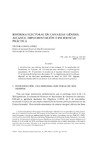Please use this identifier to cite or link to this item:
https://accedacris.ulpgc.es/jspui/handle/10553/73283
| Title: | Reforma electoral en Canarias: génesis, alcance, implementación e incidencia práctica | Other Titles: | Electoral Reform in the Canary Islands: Origin, Scope, Implementation and Impact | Authors: | Cuesta López, Víctor Manuel | UNESCO Clasification: | 560504 Derecho constitucional 590501 Elecciones |
Keywords: | Elecciones autonómicas Parlamento de Canarias Reforma Electoral Law Electoral Systems, et al |
Issue Date: | 2020 | Publisher: | UNED, Universidad Nacional de Educación a Distancia | Journal: | Teoría y Realidad Constitucional | Abstract: | La reforma del Estatuto de Autonomía de Canarias, aprobada mediante la Ley Orgánica 2/2018, de 5 noviembre, ha supuesto la modificación de las bases del particular sistema electoral canario, insistentemente demandada por la doctrina constitucional y desde amplios sectores de la clase política y la sociedad civil canaria. Esta reforma incide en la dimensión del Parlamento de Canarias, supone la creación de una nueva circunscripción de ámbito autonómico, que coexiste con las tradicionales circunscripciones insulares, altera el prorrateo de escaños entre circunscripciones y reduce drásticamente las barreras electorales. Considerando que las nuevas bases del régimen electoral canario debían ser aplicadas necesariamente en las elecciones autonómicas celebradas en mayo de 2019, ofrecemos un análisis de los instrumentos jurídicos que, a falta de una ley electoral de desarrollo, fueron utilizados para su implementación. Finalmente, y atendiendo a los resultados de las mencionadas elecciones, presentaremos algunas reflexiones sobre la modesta incidencia práctica de la reforma. The reform of the Statute of Autonomy of the Canary Islands, approved by Organic Law 2/2018, of 5 November, has finally changed the complex regime of the regional parliamentary elections, persistently demanded by constitutional scholars and civil society. This reform affects the dimension of the Parliament of the Canary Islands, involves the creation of a new regional constituency, which coexists with the traditional island constituencies, alters the apportionment of seats and drastically reduces the electoral thresholds. Considering that the new electoral regime must be applied in the regional elections held in May 2019, we offer an analysis of the legal instruments used for its implementation. Finally, and taking into account the results of the aforementioned elections, we will present some reflections on the modest practical impact of the reform. |
URI: | https://accedacris.ulpgc.es/handle/10553/73283 | ISSN: | 1139-5583 | DOI: | 10.5944/trc.45.2020.27141 | Source: | Teoria y Realidad Constitucional[ISSN 1139-5583], n. 45, p. 429-449, (Enero 2020) | URL: | http://dialnet.unirioja.es/servlet/articulo?codigo=7341468 |
| Appears in Collections: | Artículos |
Page view(s)
258
checked on Jan 25, 2025
Download(s)
134
checked on Jan 25, 2025
Google ScholarTM
Check
Altmetric
Share
Export metadata
Items in accedaCRIS are protected by copyright, with all rights reserved, unless otherwise indicated.
